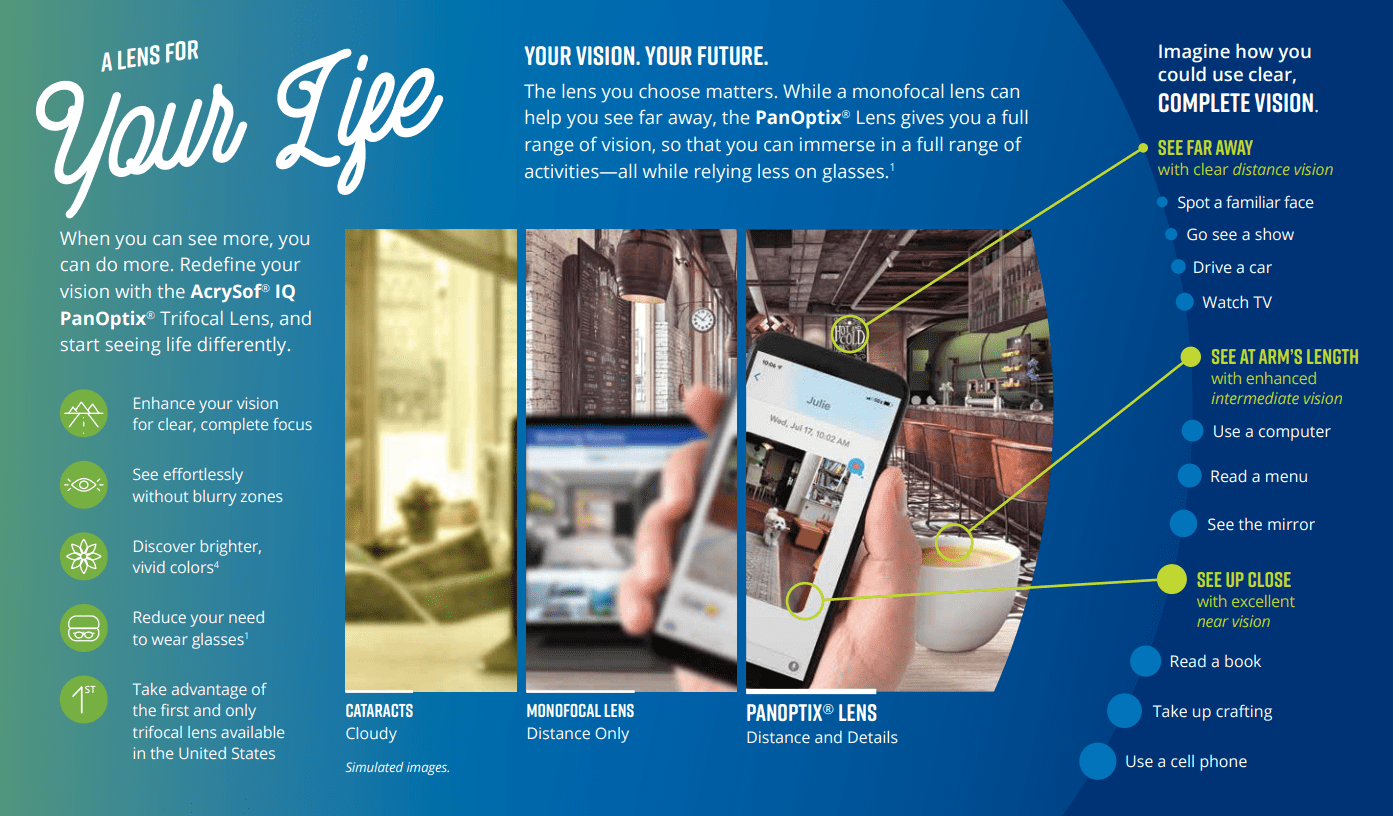PanOptix Lens: Advanced Solution for Clear Vision - Albuquerque, NM
What is PanOptix® intraocular lens (IOL)?
The PanOptix® IOL is a type of lens that is used to replace the natural lens of the eye during cataract surgery. Unlike the traditional IOL, the PanOptix® IOL is a trifocal lens, and like a trifocal eyeglass lens, a trifocal lens contains three different prescriptions in one lens, allowing the patient to see clearly at far, intermediate, and near distances reducing, or sometimes eliminating, the need for glasses or contacts. They are typically more expensive than other types of intraocular lenses. As with any medical procedure, it is important to consult with an ophthalmologist to determine whether a trifocal lens is the right choice for your specific needs.
As the first practice in Albuquerque to implant PanOptix® with Wavefront guided ORA technology, Southwest Eyecare is proud to continue to lead the industry in performing this vision-enhancing treatment. If you’re considering having cataract surgery, turn to the specialists at Southwest Eyecare to achieve the best possible results and maximize the potential for your vision.
Candidates for PanOptix Cataract Surgery
An ideal patient for the PanOptix® IOL has generally healthy eyes aside from the cataracts and
- Want to reduce their dependence on glasses: Trifocal lenses are designed to provide good vision at far, intermediate, and near distances, which can reduce the need for glasses or contacts, or even eliminate it altogether.
- Have realistic expectations: While trifocal lenses can improve vision at multiple distances, they may not completely eliminate the need for glasses or contacts, and some patients may experience visual side effects such as halos or glare.
- Are willing to pay some of the cost out-of-pocket: Trifocal IOLs are typically more expensive than other types of lenses, which may be a consideration for some patients.
- Not everyone is a good candidate for this premium lens. Your cataract screening will ensure that you have no existing conditions that may lead to problems after cataract surgery.
- We usually don't recommend trifocal IOL implants in patients with a lazy eye or crossed eyes or who don't see well out of both eyes. Finally, the PanOptix will may not work well with an irregular cornea surface, which can occur with age, certain diseases, or a history of refractive surgery such as LASIK or RK.
Benefits of PanOptix® Technology
- PanOptix® provides an enhanced combination of near, intermediate, and distance vision and substantially reduces the need for glasses.
- Considerably reduces a patient’s need for glasses after cataract surgery.
In an FDA clinical study, more than 99% of PanOptix patients said they would choose the same lens again. In addition, 98% of patients surveyed reported that they would recommend this lens to family and friends who need cataract surgery. Nearly 92% of PanOptix patients said they never or rarely use their eyeglasses after having this vision correction procedure.
Other benefits of PanOptix® cataract surgery include:
- Bright, vivid colors for a high-definition vision experience
- Effortless sight with the blurry zones sometimes reported with other lenses
Many patients experience sharp, clear vision without glasses or contact lenses, often for the first time in many years. These individuals report a higher sense of life satisfaction and appreciation compared to their lives before having cataract surgery.
FAQs
You're probably familiar with bifocal or trifocal glasses. They help correct the vision at different distances, so you can read your book, still look up, and focus on what's happening across the room. PanOptix® IOL work similarly, providing vision correction at a range of differences.
These trifocal lenses are designed to replace the damaged lens in your eye when cataracts become too severe to correct with glasses. They're made from hydrophilic acrylic, and they have 26 diffractive rings. Those 26 rings refract the light in different ways, so patients can focus on objects close to them, such as a book, at intermediate distances, such as a computer screen, and far away, such as when driving.
PanOptix® IOLs also have a filtering material to protect your eyes from blue light and ultraviolet rays.
Patients usually feel little or no pain on the day of surgery. You'll be given medication to help you relax, and anesthetic drops are used to numb your eyes. The surgery usually takes about 15 to 30 minutes per eye, and you'll be able to go home in just a few hours.
Recovery usually takes a day or two, and you will probably experience some blurriness, minor soreness, irritation, and swelling. These symptoms are usually mild and go away in a few days. Most people are completely healed within four to six weeks after surgery.
You will return to the eye doctor for a follow-up visit shortly after surgery as well as a few times in the weeks and months after. Within about three months of the procedure, we will determine whether you need a new prescription for glasses or contact lenses based on your progress.
PanOptix® surveyed patients after having this treatment and found that most experienced minimal or no discomfort during their procedures. In fact, many reported that having the surgery was not as difficult as they expected and said they wished they had not waited to get cataract and refractive lens implants.
The amount of improvement depends on the condition of your eye before surgery. Generally, within 24 hours, the blurriness from the surgery should be lessened, and you will already see things more clearly than before. Your vision will continue to improve over the next months.
Your new PanOptix® IOLs are made to last for a lifetime. Cataracts cannot come back once the original lens in the eye has been removed. In rare cases, cloudiness develops on the capsule around the new lens, but this can be quickly corrected in-office with a laser.
Your new PanOptix lenses are made to last for a lifetime. Cataracts cannot come back once the original lens in the eye has been removed. In rare cases, cloudiness develops on the capsule around the new lens, but this can be quickly corrected in-office with a laser.
With any cataract surgery, patients often experience dry eyes and light sensitivity as their eyes heal. You may also have other side effects, such as visual disturbances. These visual disturbances mean things look a little different, such as seeing a halo or rays around lights. You may also find distinguishing objects from their background difficult, particularly in low light, making driving more difficult at night.
Most of the time, patients report that these symptoms decrease in the months after surgery and become less of a problem over time.
You may also experience some blurriness as your brain adapts to your new range of vision. Within six months, most people can adapt and see clearly at low, intermediate, and far distances.
Have questions or want more information?
Schedule an evaluation today or give us a call!
Southwest Eyecare
7110 Wyoming Blvd NE
Albuquerque, NM
Phone: (505) 346-0500
Fax: (505) 346-0164
Our Location
7110 Wyoming Blvd NE
Albuquerque, NM 87109

